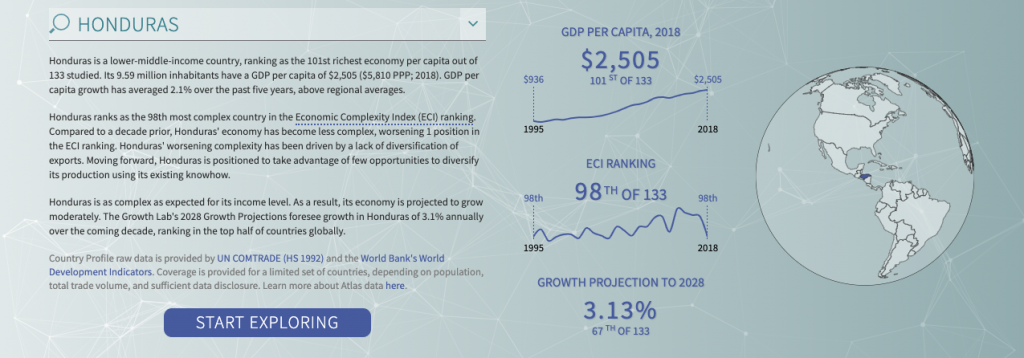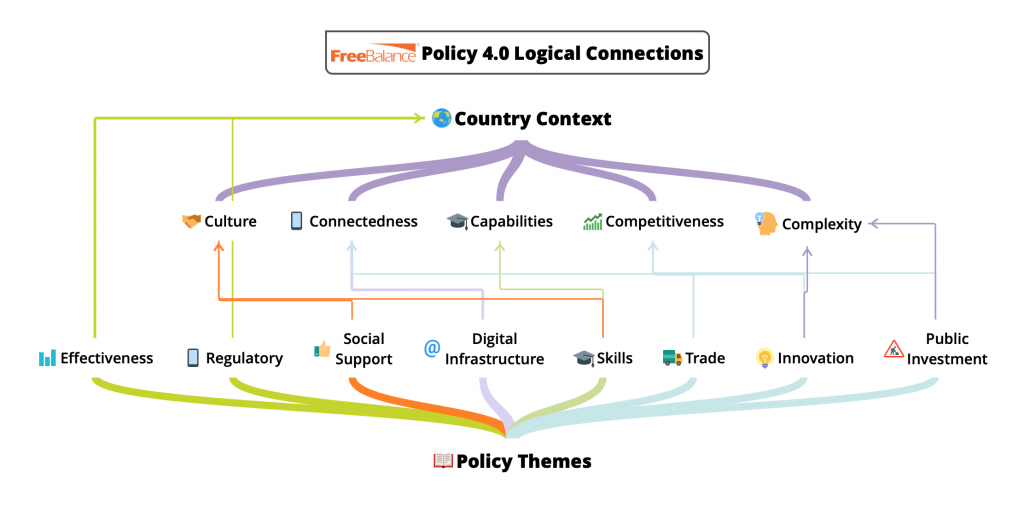Industry 4.0, or the Fourth Industrial Revolution (4IR), challenges Emerging Markets and Development Economy (EMDE) government to “reassess their national competitive advantages and development strategies1.” Developed countries benefit from advanced technology manufacturing, intellectual property, and knowledge economies. Limited retooling is required in these countries to exploit Industry 4.0. Developed country governments exhibit sophisticated policy design. EMDEs, with lower government effectiveness, and less sophisticated manufacturing are more vulnerable to 4IR effects.
Are integrated Global Value Chains (GVCs) the development solution for potential disruptive 4IR impacts on EMDEs? “A global value chain breaks up the production process across countries. Firms specialize in a specific task and do not produce the whole product.2”
How can EMDE policymakers navigate 4IR and GVC complexity? Policymakers can leverage “Policy 4.0” frameworks to make multiple year interventions more coherent. Industrial, trade, education, and innovation merge in Policy 4.0.
Policy 4.0 frameworks are designed to be “coherent, consistent and mutually enforcing3” “to build 4.0 institutions, 4.0 governance, 4.0 states, 4.0 labor forces, and 4.0 entrepreneurs.4” An effective policy 4.0 framework is designed to “(a) sustain overall industrial performance, (b) in a way that helps close the gap to the frontier in a constantly evolving technological landscape, (c) while mitigating the adverse consequences for society, in terms of employment, privacy and latent social fabric5.”
Government and Country Context
EMDEs possess differing potential and vulnerability to 4IR and GVC economic and social effects. Policy intervention success relies on aligning to the government and country context. Effective policy optimizes potential while mitigating vulnerability. Policy-makers can analyze culture, connectedness, capabilities, competitiveness, and complexity to understand context.
Culture
Culture determines the change space. Citizen views towards growth, equity, environment, and well-being with different notions of prosperity define perceptions of government effectiveness. Cultural analysis identifies improved success measures better than traditional metrics like GDP such as Gross National Happiness used by the Government of Bhutan and metrics from the World Happiness Report. Will EMDE country citizens reject 4IR policy interventions that grow economies at the expense of increased inequity, resource depletion, or mental stress?
Connectedness
Connectedness determines the global integration space. Countries have varying levels of “participation in international flows of products and services (trade), capital, information, and people.6” Most emerging economies and developing countries have poor levels of global connectedness meaning that many potential 4IR interventions will not be effective. Can policy-makers in emerging economies and developing countries effectively leverage and improve current connectedness to leverage 4IR opportunities?
Capabilities
Capabilities determines the knowledge space. Human capacity supported by education systems and cultural norms determines how countries can benefit from the knowledge economy and “future of work” changes from automation. Educational outcomes are poor in most emerging economies and developing nation, giving advanced economies more opportunity to win the 4IR “war for talent.” Can policy-makers in emerging economies and developing countries overhaul education systems “to support technology diffusion and innovation?7”
Competitiveness
Competitiveness determines the productivity space. Competitiveness among countries and sectors differ. Competitiveness measures “an economy’s level of productivity.8” Advanced economies have far higher levels of productivity. 4IR changes the nature of productivity through massive automation. Can policy-makers in emerging economies and developing countries find ways to improve productivity through 4IR investments?
Complexity
Complexity determines the sector space. Economic complexity recognizes the “composition of a country’s productive output and reflects the structures that emerge to hold and combine knowledge.9” Country economies leverage expertise to enter adjacent markets effectively. Advanced economies benefit from higher economic complexity. Can policy-makers in emerging economies and developing countries effectively identify adjacent and more advanced markets for economic penetration leveraging 4IR technologies?

Potential EMDE Effects with GVC & 4IR Integration
The country context and “national political and policy responses, along with geopolitics, are likely to play a major role in deciding IR 4.s winners and losers.10” Potential and vulnerability differ widely among EMDEs. Labour substitution, re-shoring, and sustainability are some common effects for policy-makers to consider. Effective GVC polity can optimize 4IR potential while mitigating vulnerabilities.
Industrial Labour Substitution Impact
Developing nations and emerging economies benefit from labour arbitrage in global supply chains. “Unlike the first three industrial revolutions, IR 4.0 has elements that substitute capital for labour rather than complement labour11.”
- Vulnerability: 4IR disrupts employment, particularly less-skilled jobs, burdening government social safety nets.
- Potential: 4IR technology is affordable and available for “technology leapfrogging.” Traditional industrial economies of scale no longer matter in Industry 4.0. EMDEs can compete through this technology democratization. The good news is that “automation is compressing labor’s income share but not necessarily reducing employment12” suggesting that policy space exists.
Outsourcing Market Impact
EMDEs benefit from labour arbitrage in outsourcing services like call centres, software development, and Business Process Outsourcing (BPO). 4IR enables firms to “re-shore”.
- Vulnerability: Chatbots, Robotic Process Automation (RPA), and machine learning reduces BPO employment.
- Potential: EMDEs can develop “hyperspecialization” . The “evidence on reshoring is limited*” validating the potential of GVC hyperspecialization13.”
Sustainable Development Impact
4IR presents “significant opportunities as well as challenges for developing countries[16]” in achieving the 17 Sustainability Development Goals (SDGs).
- Vulnerability: Technology also threatens to intensify global problems. Economic growth through 4IR can increase inequality, pollution, and poverty while making countries more susceptible to climate change, resource loss, and food insecurity. “Scale effects—which refer to the rapid growth of GVC economic activity—are bad for the environment, whereas composition effects—which refer to how tasks are distributed across the globe—have ambiguous effects.14”
- Potential: Technology promises to solve global “wicked problems”. 4IR can provide tools for countries to reduce consumption and pollution, improve resource usage and food security, and mitigate climate change. GVC “Technique effects—which refer to the environmental cost per unit of production—are positive for the environment15.”
4IR/GVC Policy 4.0 Intervention Recommendations

Policy 4.0 Logical Connections
Policy-makers in developing countries and emerging economies can adopt solutions aimed at exploiting potential while reducing vulnerability. These can be prioritized and sequenced based on heat mapping and scenario analysis to develop realistic national development plans. These scenarios project which policy interventions will have the most impact:
- Effectiveness: improve government performance through anti-corruption and institutional reform, to improve policy certainty and the rule of law
- Regulation: adapt legal and regulatory frameworks by removing barriers to digital adoption, enabling competition, easing doing business, simplifying firm entrance and exits, and adapting to the realities of digital technology business models like the sharing economy
- Social Support: develop social protection including employment protection, improving social safety nets and employment equity
- Digital Infrastructure: improve digital and ICT infrastructure development, enable digital payments, and reduce the “digital divide”
- Skills Development: develop country human capacity through education reform, re-skilling, the use of digital education to foster lifelong learning, and methods to attract highly-skilled expats to return
- Trade Facilitation: improve international economic integration through trade agreements, augmented with physical infrastructure for logistics, reduced tariffs on necessary digital technology
- Innovation Investment: enable innovation through tax incentives, innovation districts, leveraging government buying power, research grants, and research and development credits
- Public Investment: leverage Innovative financing models, including Public-Private Partnerships to increase innovation investments, and including the use of data as a development asset by encouraging business to monetize open data for products and services through “government as platform16”
Conclusion
GVCs are part of the solution to optimize 4IR effects in EMDEs. Policy-makers can optimize 4IR potential while mitigating vulnerability through articulating country context, analyzing potential scenarios based on this context, defining national strategies and interventions based on scenarios, and tracking progress.
1Technology Innovation Future of Production. World Economic Forum, 2017
2 World Development Report 2020: Trading for Development. World Bank, 2019.
3John Bachtler, Joaquim Oliveira Martins Peter Wostner, and Piotr Zuber. Towards Cohesion Policy 4.0: Structural Transformation and Inclusive Growth. Regional Studies Association (RSA) Europe, 2017.
4Arnab Das. Industrial revolution 4.0: ghosts of disruption past, present and future. Invesco, 2018.
5Padmashree Gehl Sampath. Industrial Policy 4.0: Promoting Transformation in the Digital Economy. Global Development and Environment Institute, 2018.
6Steven A. Altman, Pankaj Ghemawat and Phillip Bastian. DHL Global Connectedness Index 2018 The State of Globalization in a Fragile World. Deutsche Post DHL Group, 2018.
7IBID
8Klaus Schwab (ed). The Global Competitiveness Report 2018. World Economic Forum, 2018.
9Ricardo Hausmann, César A. Hidalgo, Sebastian Bustos, Michele Coscia, Alexander Simoes, and Muhammed A. Yildirim. The Atlas of Economic Complexity: Mapping Paths to Prosperity. MIT Press, 2013.
10Arnab Das. Industrial revolution 4.0: ghosts of disruption past, present and future. Invesco, 2018.
11 IBID
12 World Development Report 2020: Trading for Development. World Bank, 2019.
13 IBID
14 IBID
15 IBID
16Tim O’Reilly. Government as Platform. Innovations, MIT Press, 2011.
